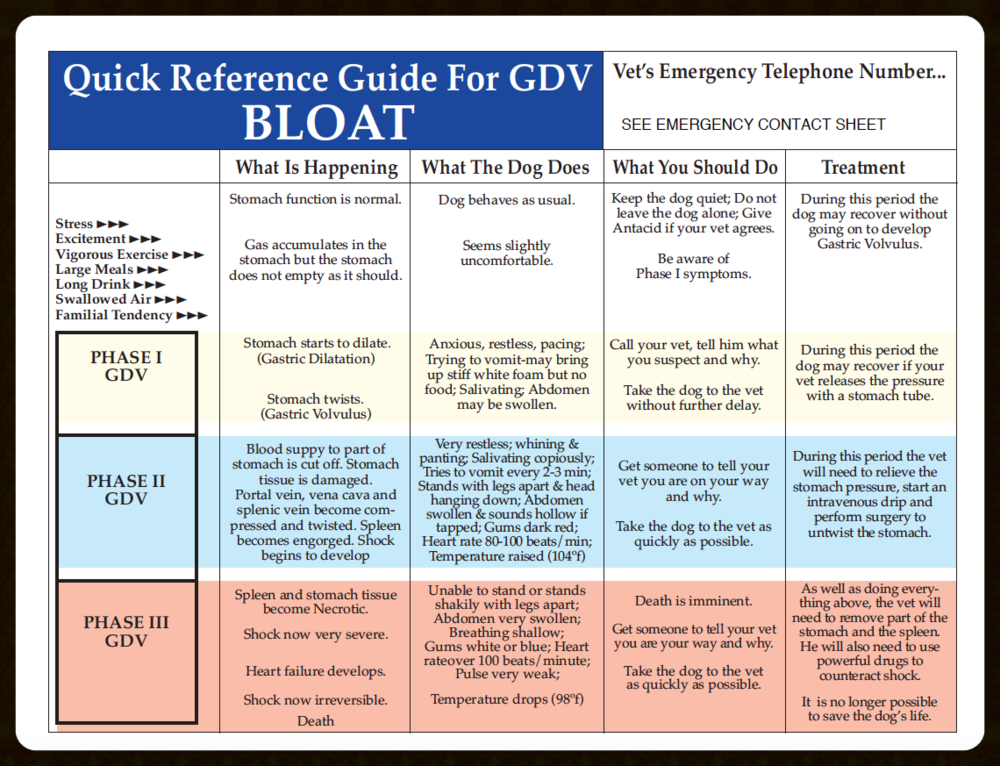Health and Welfare
Inherited and other health concerns in the Great Dane:
Whether you are purchasing a pet or intending to breed it is important to know the health status of your Great Dane before breeding any dog or bitch. Clinically affected dogs, i.e., those dogs exhibiting symptoms for conditions considered serious and heritable should generally NOT be bred and health screenings (where available) are recommended. Please note that the text below is intended as an aid to those seeking health information on the breed, and should not be used to form a diagnosis replacing regular veterinary care by a qualified veterinarian.
GDV: Bloat - is the number one killer of Great Danes & Great Danes are the #1 breed at risk for bloat. For reasons not fully understood, in certain deep-chested breeds in particular, the stomach distends, then has a tendency to rotate, which cuts off the blood supply to various parts of the body, as well as effectively shutting down digestion. This condition is extremely painful as well as a true emergency that is rapidly life threatening. A dog with a bloated, twisted stomach (technically called "Gastric Dilatation and Volvulus") will die in great pain in a matter of hours unless drastic steps are taken: surgery is normally necessary. The reasons for GDV are currently not understood, however most would agree that multiple small meals per day and preventing vigorous exercise around mealtimes can help reduce the chances of bloat. Many breeders and owners of Great Danes consider a surgery called a prophylactic gastropexy ("preventative tack") which can help prevent some of the more serious aspects of GDV. Discuss this with your veterinarian and your Dane's breeder.See also this chart on Prophylactic Gastropexy (the preventitive "tack" surgery).

DCM: CARDIOMYOPATHY - is suspected to be an inherited disease in the Great Dane and current (preliminary) research indicates that this disease may be sex-linked in our breed. Research is ongoing. An echocardiogram of the heart will confirm the disease but will not guarantee that the disease will not develop in the future. Regular exams on breeding stock are recommended. There are some congenital heart defects also occasionally found in the breed. For an in-depth article on the subject, see "Heart Disease in the Great Dane."
K9HD: HIP DYSPLASIA - is an inherited disease with multi-factorial
expression. Clinically the disease may be seen as simply poor rear end conformation or lessened athleticism to such malformation of the hip joint that the dog becomes crippled. It is recommend that breeding stock be Xrayed as normal. OFA and PennHIP both offer certification programs.
See OFA and PennHIP.
HYPOTHYROIDISM & other heritable endocrine disease - Hypothyroidism in dogs is generally the result of a heritable disorder of the immune system. This condition results when the thyroid gland is not producing enough hormone to adequately maintain the dog's metabolism. Happily, it is easily treated with thyroid replacement pills. Thyroid testing (T4, TSH and autoantibodies) on breeding stock should be performed on a routine basis. Finding autoantibodies to thyroglobulin is normally an indication that the dog has autoimmune thyroiditis. Low thyroid dogs, manifested by a high TSH and a low T4, should be treated and monitored on a regular basis. Dogs with confirmed thyroid abnormalities should not be bred. Another autoimmune endocrine disease that can affect the breed is Addison's disease. See the link on Addison's Disease Info in the Research section to learn more about both the ongoing research project as well as how to diagnose and treat dogs with Addison's disease.
CATARACTS - although not common, cataracts have been described in the Great Dane and can be blinding. Eyelid abnormalies (e.g. entropion) are also not unheard of in the breed. For breeding stock a CERF exam can insure that the eyes are normal in all aspects.
CANCER: Danes can suffer from a variety of cancers as do many other breeds of dogs as well as many mixed breed dogs. Bone cancer (osteosarcoma) and lymphoma appear to be the two forms of cancer most commonly seen in the Great Dane, and along with heart disease and bloat (GDV), cancer is a leading cause of death in Great Danes. Research into both types of cancer is ongoing and treatment options are improving every day. See The Genetics of Cancer
CVI: Wobblers - is a result of pressure on the spinal cord in the neck region and results in a "drunken" gait & increasing instability. The congenital form of CVI in Danes usually presents in the first year and is a malformation of the cervical vertebrae thought to result from a combination of nutritional effects and inherited traits; it is considered a form of DOD (Developmental Osteodystrophy) along with such as OCD. A whiplash sort of traumatic injury to such long-necked dogs as Danes can and does occur in adult dogs and can also be referred to as "Wobblers" or CVI. Great Danes are considered at risk for both congenital & trauma induced "Wobblers." CVI stands for Cervical Vertebral Instability.
HOD and Pano - these are painful conditions of the bones that occur during the rapid growth phase of puppyhood causing lameness and general malaise. By far HOD is the more serious one and can be deadly. Pano is usually self-limiting and may not need treatment. HOD stands for Hypertrophic Osteodystrophy. Pano is short for Panosteitis.